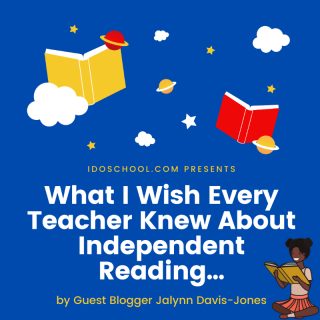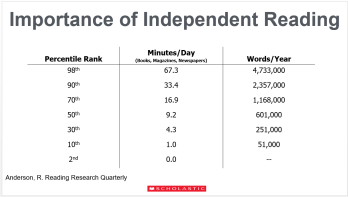What I Wish Every Teacher Knew About Independent Reading...
Jan 26, 2021

By now the second semester of school is in full swing - with some students teaching and learning traditionally (in-person & face to-face), while others are doing so solely online or in a hybrid format. This is the time of the school year when educators are laser-focused on ensuring students are meeting and/or exceeding all necessary benchmarks to proficiently complete their assigned grade levels. Whole group instruction, small group instruction, differentiated instruction, equitable opportunities, (cue ominous music) STATE TESTING and END OF YEAR BENCHMARKS are all swirling around in the heads of educators as we make the mad dash to the finish line -- the end of the school year.
As we press forward, a GREAT question to reflect upon as practitioners comes to mind:
“What else can I do to ensure my students are learning? I've planned beautiful lessons, implemented strategies...and the list goes on but what else can I do?”
Working tirelessly to check off the boxes, we occasionally miss something so simple yet so effective -- INDEPENDENT READING. I know, I know, it sounds like a good idea, but how do we monitor its effectiveness? How do I know what my students are learning or if they are learning anything at all? Sometimes it’s not about measuring growth in numbers. It’s about creating opportunities for exposure and watching our students blossom in ways that measurement cannot define.
In The Power of Reading, Dr. Stephen Krashen states: “The single factor most strongly associated with reading achievement - more than socioeconomic status or any instructional approach - is independent reading.” The chart below shows the correlation between reading achievement percentile ranks and the number of minutes read per day.

The data is clear - the more minutes students read results in higher percentile ranks in reading achievement AND results in the acquisition of more words. Structured independent reading is the gift that keeps on giving. By providing opportunities to support learners through independent reading we can:
This all sounds great…right? But the big question is “HOW?” How do we “open” the gifts of independent reading ? For some educators the whole idea of independent reading is still somewhat of an elusive concept.
Well I’m glad you asked.
Here are some simple, yet actionable steps to increasing independent reading, all while monitoring student performance, creating a joyful learning opportunity.
Remember our goal is to reap the benefits of increased opportunities for reading – by any means necessary! Research (see 10 Ways to Promote Independent Reading - #’s 3,4 & 5 are my favs), collaborate with colleagues, find a thought partner (email me if necessary) and lastly BE CREATIVE—WE ARE TEACHERS – finding ways to support our students is only one of our super powers. I’m just a teacher who loves literacy, learning and teaching. These are my thoughts on independent reading … What are yours?
About the Author:
Jalynn Davis-Jones is an educator of 16 years. Her professional experiences include delivery of instruction in early childhood, curriculum content mapping, instructional coaching, professional learning facilitation, district and school level administration, and she currently works in educational publishing with a literacy focus. She is a life-long learner with a passion for teaching, learning and equitable practices for all.

As we press forward, a GREAT question to reflect upon as practitioners comes to mind:
“What else can I do to ensure my students are learning? I've planned beautiful lessons, implemented strategies...and the list goes on but what else can I do?”
Working tirelessly to check off the boxes, we occasionally miss something so simple yet so effective -- INDEPENDENT READING. I know, I know, it sounds like a good idea, but how do we monitor its effectiveness? How do I know what my students are learning or if they are learning anything at all? Sometimes it’s not about measuring growth in numbers. It’s about creating opportunities for exposure and watching our students blossom in ways that measurement cannot define.
In The Power of Reading, Dr. Stephen Krashen states: “The single factor most strongly associated with reading achievement - more than socioeconomic status or any instructional approach - is independent reading.” The chart below shows the correlation between reading achievement percentile ranks and the number of minutes read per day.

The data is clear - the more minutes students read results in higher percentile ranks in reading achievement AND results in the acquisition of more words. Structured independent reading is the gift that keeps on giving. By providing opportunities to support learners through independent reading we can:
1) Increase student engagement through student choice and actively engage students.
2) Provide exposure to and increase academic vocabulary and understanding of key concepts directly related to the subject matter at hand.
3) Build reading stamina (this is most definitely needed when it comes to testing -- but that's a whole other blog ☺ ).
This all sounds great…right? But the big question is “HOW?” How do we “open” the gifts of independent reading ? For some educators the whole idea of independent reading is still somewhat of an elusive concept.
Well I’m glad you asked.
Here are some simple, yet actionable steps to increasing independent reading, all while monitoring student performance, creating a joyful learning opportunity.
1. Put books in the hands of students. How? Create a classroom library – a good library consists of approximately 750 books. Yes, I know this is a lot of books – where are you going to house them? By utilizing both print and eBooks. If your school/district hasn’t implemented an eReader program/platform, strongly recommend (or beg) your administrator for one. If accessing a paid program is not an option check out your local library online databases or you can access children’s books online for little to no cost. This will add to your arsenal of instructional tools, while expanding your library immediately without the physical need for storage. But don’t stop at creating your classroom library - expand your students’ home libraries through the creation of a take home pack of books. Look for agencies that provide free books, partner with community organizations, or solicit adopters In doing this, you engage your families by encouraging reading at home.
2. Utilize time before school, after school and break times to encourage independent reading. Place book baskets in the hallways, on busses and in the cafeteria. In online learning environments, designate times for independent reading and direct students to utilize online resources through the local library or other platforms. You can also load hyperlinks to direct students to books online to your learning management system - i.e. your stream in Google classroom. If students have free choice in the selection of books they will read!
3. Encourage student choice. Think about your favorite book or how you feel when selecting a book to read. Students should have the opportunity to get that same warm, fuzzy feeling when selecting a book. Don’t stifle students by confining them to a “reading level.” This takes the JOY out of reading. With your guidance, students should find books that pique their curiosity and spark interest within.
By the way - It does not matter if the book is above or below their instructional reading level as determined by assessments; the goal is to increase the number of minutes students are reading, which results in increased exposure to vocabulary and increased reading stamina. Grappling with complex text is completely ok – if students are interested (since they chose the book they most likely will be), they will figure it out or seek help to gain understanding.Remember our goal is to reap the benefits of increased opportunities for reading – by any means necessary! Research (see 10 Ways to Promote Independent Reading - #’s 3,4 & 5 are my favs), collaborate with colleagues, find a thought partner (email me if necessary) and lastly BE CREATIVE—WE ARE TEACHERS – finding ways to support our students is only one of our super powers. I’m just a teacher who loves literacy, learning and teaching. These are my thoughts on independent reading … What are yours?
About the Author:
Jalynn Davis-Jones is an educator of 16 years. Her professional experiences include delivery of instruction in early childhood, curriculum content mapping, instructional coaching, professional learning facilitation, district and school level administration, and she currently works in educational publishing with a literacy focus. She is a life-long learner with a passion for teaching, learning and equitable practices for all.


